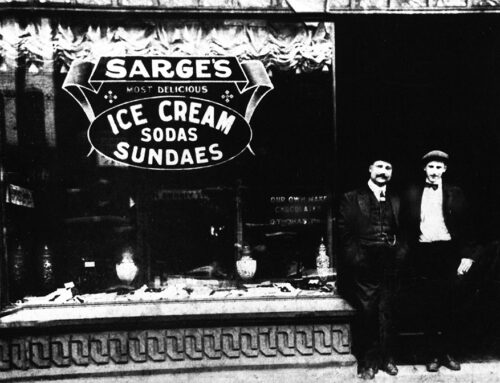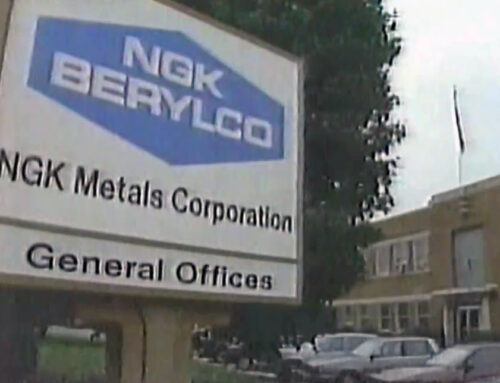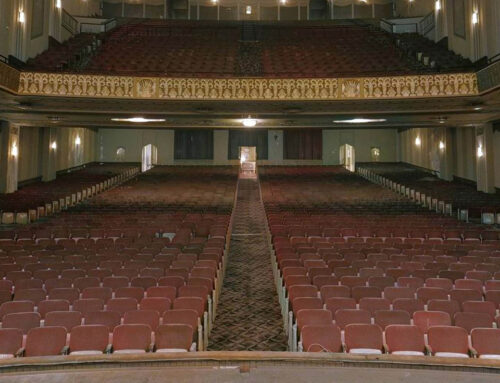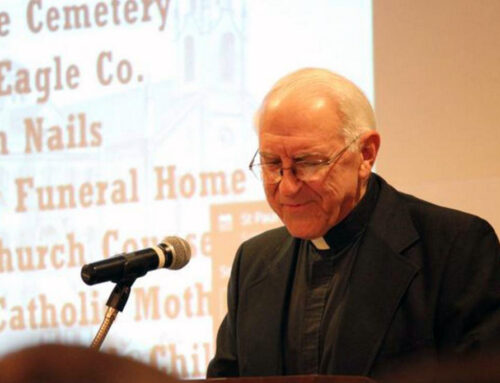The Colonial Theatre, built by Carr and Schad in 1916 on the Breneiser property at 651–667 Penn Street between Ellis Mills and Hotel Allen, was the first premium movie house built “uptown.” The film “Sleeping Fires,” starring Pauline Frederick, opened on April 15, 1917. On that day, the Reading Eagle published an artist’s rendering of the new movie theater and an article about its $250,000 opening. A newspaper staff writer called the Colonial “one of the finest theatres in the country,” explaining that Reading’s newest cinema entertainment center was created after months of research and a detailed examination of representative theatres in the main US cities. He added, “patrons will be much delighted with the interior which was designed to impress.” The Colonial Symphony Orchestra, led by Reading Symphony Orchestra organizer and conductor Harry E. Fahrbach, was a highlight.
Below: North side of Penn Street near Seventh, 1934. The Colonial Theatre, erected in 1916 at 651-657 Penn, became “Loew’s Colonial” in 1925. The Ellis Mills building, at the turn of the century, was Jonathan Mould’s well-known “Busy Bee” store. Mould was the gentleman who “bought” the Pagoda and donated it to the city in 1911. At 661 Penn was Chic Millinery, operated by Wm. F. Tannenbaur. The Allen Hotel stood on the comer — over the Colonial Soda Grill and the United Cigar Store.

The Colonial opened during World War I, when gasoline shortages and Liberty Bond drives halted performances. However, this Reading cinema house showed the best films and plays. Rudolph Valentino’s “The Four Horsemen of the Apocalypse” set early attendance records, possibly due to wartime entertainment seekers. The Colonial’s most significant event was Galli Curci’s concert on October 21, 1920. Front row seats were $5 and loge seats $10, a fortune for most people then. The event was a hit, with hundreds lined the curbs to see the trendy audience. The Carr and Schad business produced Reading’s only newsreel, “Community Events,” for over 10 years, covering all major city and county events. For the first few years, Mike Carmen, Harry Stimmel, and Clarence Latshaw managed, with Alfred Seward and Robert E. Henke as organists.
When Loew’s Incorporated bought the Colonial from Carr and Schad, who moved to the 700 block of Penn Street in Arcadia, the MGM lion entered on September 21, 1925. There was no interruption since the old firm closed Saturday night and the new one launched Monday.
At the new MGM Loew’s, regular movies and stage performances continued. Harry E. Fahrbach directed the orchestra, Robert E. Henke played organ, and Mabel E. Stoudt played relief organ. When the Loew’s opened in September, the Reading Eagle advertised the film “Ever the Twain Shall Meet” and the Colonial Concert Orchestra’s overture, “The Life of Stephen Foster.” Short films, a theatrical show, and organist Henke’s novelty performance were also shown. After installing a $50,000 Wurlitzer Pipe Organ in July 1926, a new cooling system was added. Loew’s got sound equipment in 1929. Early managers included Larry Jacobs, Howard Foerste, Livingstone Lanning, and Robert Suits.
On January 14, 1932, child actor Jackie Cooper appeared at the theater, which hosted Reading’s destitute children and children from St. Catherine’s Orphanage and other institutions. The show drew 1,800 kids. Many stars, including Eddie Cantor, visited the Loew’s in the 1930s. It was the first dawn showing of a film in Reading at this Penn Street theatre on February 18, 1935. The management offered free coffee and donuts to patrons who wanted to take a picture before work or after a night shift tour. Ironically, the inaugural breakfast show aired Clark Gable’s “After Office Hours.” This cinema house lowered Friday matinee prices to 25 cents for adults and 15 cents for children in the 1930s. Evening concerts cost 40 cents and 15 cents, with balcony tickets costing 25 cents.
It was shocking in 1939 when Reading, Pennsylvania, was one of a few places to premiere David O. Selznick’s “Gone With the Wind.” The Reading Eagle reported on December 11 that “GWTW” would start in New York, Los Angeles, Boston, Atlanta, Cincinnati, Houston, and Reading. This numerous Academy Award-winning film opened at Reading’s Loew’s Theatre on December 21, 1939, and ran for four record-breaking weeks. As the ad campaign claimed, Reading welcomed the picture “with open arms.” W.T. Grant’s “GWTW” prints let ladies make their favorite cinema gowns. The five-and-dime sold “Gone With the Wind” scarves. The American House at Fourth and Penn hosted “Plantation Days,” a film-inspired Southern music performance. The posh Jeannette Shop featured “authentic reproductions of the original ‘GWTW’ gowns.” Andrews Cutrate offered a “exciting plastic figurine” of Scarlett for ladies’ dressing tables and a “irresistible new nail polish” to bring her charm to every woman. People’s Service Store offered $1.50 a pound “GWTW” chocolates for chocoholics, and a local auto dealer advertised fast cars that would be “gone with the wind.” Readingites had a thrilling four weeks. On August 20, 1961, Bertrand Mellinger, the Loew’s main projectionist from 1927 to 1963, told the Sunday Eagle Magazine that he had exhibited this major motion film so many times he virtually remembered the script.
Below: Reading Eagle ads highlighting Reading’s celebration of the premiere of “Gone With The Wind” which opened at the Loew’s on December 21,1939.

War brought bond campaigns to movie theaters in the 1940s. World War II had to be depicted in pictures, and it was in “Flying Tigers,” “The Purple Heart,” and MGM’s “Salute to the Marines” at the Loew’s on September 15, 1943. These films reminded patriotic Americans to “Back the Attack – Buy War Bonds.” The Loew’s joined other city theaters in wartime parades, drives, and rallies. On August 1, 1941, Larry Levy succeeded W. Brock Whitlock as manager of this movie palace.
MGM produced lavish technicolor musicals in the 1940s, starring Judy Garland, Gene Kelly, Fred Astaire, Jane Powell, Mickey Rooney, Esther Williams, and others. Louis B. Mayer claimed that the studio had “more stars than there are in the heavens.” They all played Loew’s. These years, the theatre offered additional activities and contests in addition to movies. On July 19, 1946, the city’s playground boy and girl finalists battled for the “freckles crown” at Loew’s. The theatre was happy to announce that Reading’s Bicentennial Queen, Miss Marie E. Henne, would attend the press review of “State of the Union,” at the Loew’s Capitol Theatre in Washington, D.C., in 1948. Also that year, the local theatre’s publicity department claimed in a Reading Eagle ad that the Seventh and Penn police were amazed by the throngs stopping traffic to see Judy Garland and Fred Astaire in “Easter Parade.” During the Loew’s heyday, jars with Berks County community names were placed on tables outside the theater for the March of Dimes. Patrons deposit dimes in their community jars to help that area raise the most money for the cause.
Larry Levy ran the Loew’s throughout the 1950s when attendance dropped. In the early years of that decade, teenage girls packed the theater whenever a film featured their heroine, Esther Williams, rising from the MGM-blue sea like Neptune’s daughter and waving a sparkling light wand. The management also revived 1935’s “Mutiny on the Bounty” and 1937’s “A Day at the Races.” Robert Diem took over the management in 1956 and managed it until March 1963, when the Loew’s lease expired and the Stanley Warner Corporation leased the movie palace, renaming it “Stanley Warner’s Colonial.” The Loew’s auditorium had 1,700 seats compared to the Warner’s 1,150, so Bert Leighton, who had managed the Warner on the 700 block of Penn Street, thought it was a sensible move. However, Robert Diem believed Reading had too many theaters for the small clientele and number of decent movies, so the ancient cinema house had no future.
Below: North side of 600 and 700 block of Penn Street, 1942.

For approximately the next five years, Warner operated the former Loew’s, but the days of the glorious MGM technicolor movies were gone. Gone also were the lines which used to stretch for a block down Penn Street. In 1968, owners tried to revive the Colonial. In 1970, the name on the marquee read, “James Maurer Colonial.” Maurer had operated the theatre for a few months in 1969 before closing it for good. The Colonial Theater and adjacent buildings at the northwest corner of 7th and Penn streets were demolished in 1970 by the Reading Redevelopment Authority to clear land in the Downtown East renewal project area.
Below: Demolition of the Colonial Theatre, 1970.

The article in the Reading Eagle on March 18, 1970, detailing the demolition of the once-magnificent movie house was entitled “Not ‘West Side Story’ But More Like ‘Gone With the Wind.’” The old theatre came tumbling down to make way for the Penn Mall which was never built. Accompanying the article were two photos of the rubble left behind by the destruction of Reading’s first deluxe uptown movie palace. With a few swings of the “grim wrecker’s” ball, the Loew’s was truly “gone with the wind.”
Below: Construction of the General Battery Corporation building (bottom right) as their Reading Headquarters. The building was designed by Muhlenberg Greene Architects and constructed in 1978 by the Burkey Construction Company. Exide Corporation, a subsidiary of General Battery took over the building and sold it in 1998 to a private investor/operator. In 2001, Shuman Development Group purchased the General Battery Building, their first large scale commercial building.

Below: North side, East end of 600 block of Penn Street, present day.







Leave A Comment